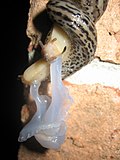 | females are often longer and stouter. Males also have a prominent copulatory bursa posteriorly. N. americanus is generally smaller than A. duodenale,... 15 KB (1,745 words) - 21:02, 20 February 2024 |
 | Tail of adult male of A. cantonensis, showing copulatory bursa and long spicules (arrows), scale bar is 85 μm... 44 KB (4,577 words) - 15:56, 22 April 2024 |
characterized by a reduced buccal capsule and square head, and well-developed copulatory bursa in the male. The genital cone ventrally bears two small slender papillae... 28 KB (4,114 words) - 05:23, 23 April 2024 |
leading to a fully developed gastrointestinal tract. Males have a small copulatory bursa at the posterior. Females have a "barber pole" shape down the middle... 17 KB (2,097 words) - 21:01, 18 April 2024 |
 | two broad lateral lobes and a smaller dorsal lobe with rays on the copulatory bursa. These bursal rays' aids in distinguishing the different species of... 10 KB (1,180 words) - 07:42, 14 April 2024 |
posterior end, while males have a feathery posterior end owing to their copulatory bursa. Hookworm species are not easily distinguished from the gross appearance... 15 KB (1,734 words) - 17:38, 2 December 2023 |
 | cell. All freshwater planarians have an accessory organ called copulatory bursa or bursa copulatrix, which is connected to the genital atrium by a canal... 5 KB (425 words) - 10:25, 4 December 2023 |
 | short penis papilla, short genito-intestinal duct, and a lack of a copulatory bursa. M. robusta can reach up to 50 mm long and is around 2–3 mm wide. The... 2 KB (180 words) - 05:03, 6 January 2024 |
the copulatory apparatus. The male copulatory apparatus has a large seminal vesicle and a penis papilla, while the female organ has a seminal bursa (or... 2 KB (158 words) - 13:42, 21 November 2021 |
 | are longer, ranging from lengths of 10 to 30 cm. Males also have copulatory bursas, used to hold on to the female during copulation and cement glands... 11 KB (1,230 words) - 13:38, 19 August 2022 |
the copulatory apparatus having a large seminal bursa (or bursa copulatrix) connected to the vagina by a canal, called Beauchamp's canal. This bursa also... 2 KB (203 words) - 13:30, 21 November 2021 |
 | have testes that are between 2.20 and 3.00 mm by 0.50 to 0.80 mm, copulatory bursas used to hold on to the female during copulation, and eight cement... 50 KB (5,760 words) - 22:39, 13 January 2024 |
 | male sample had two spherical testes, 216 × 272 µm in diameter. The copulatory bursa was 80 by 140 µm. The cement glands were indistinct. The eggs measured... 10 KB (952 words) - 20:44, 7 April 2024 |
forming a ring zone. The copulatory apparatus has a well-developed conical penis papilla and the female atrium lacks a seminal bursa, having only the female... 2 KB (134 words) - 14:04, 23 November 2021 |
musculature and strong parenchymal musculature forming a ring zone. The copulatory apparatus has a well-developed conical penis papilla and two female ducts... 2 KB (167 words) - 13:32, 23 November 2021 |
Bird anatomy (section Bursa of fabricius) 0.CO;2. S2CID 5717257. Arnqvist, G.; I. Danielsson (1999). "Copulatory Behavior, Genital Morphology, and Male Fertilization Success in Water... 80 KB (9,413 words) - 18:52, 12 March 2024 |
 | back of the ears project beyond the tip as a definite tuft. The anterior bursa flap of the ears is more widely and less deeply emarginate. The tail is... 34 KB (3,684 words) - 22:16, 21 April 2024 |
 | male copulatory apparatus is often complicated and has a well-developed penis. The female apparatus is very variable, with or without a seminal bursa and... 3 KB (260 words) - 16:27, 7 February 2024 |
 | recipient's reproductive system: the bursa copulatrix (sperm digestion organ) becomes closed off, and the copulatory canal (leading to the sperm storage)... 39 KB (3,516 words) - 17:10, 9 March 2024 |










